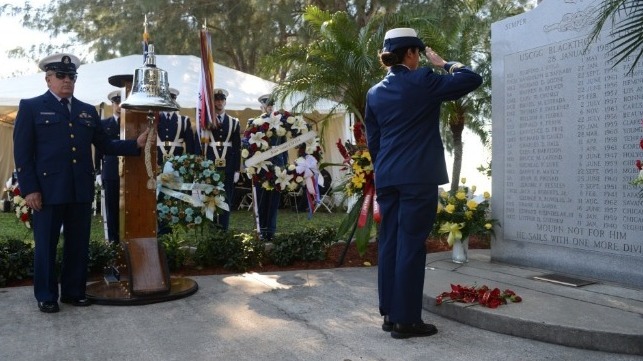40th Anniversary of the Loss of the Buoy Tender Blackthorn

One of forty 180-foot buoy tenders built during World War II, Blackthorn (WLB-391) was commissioned on March 27, 1944. The principal job of a buoy tender is to service aids-to-navigation. However, as with all Coast Guard craft, buoy tenders are often diverted to other missions, like the Blackthorn early in her career. During her first few months in service, Blackthorn broke ice on the Great Lakes to keep open wartime shipping lanes. By mid-1944, the buoy tender was assigned to San Pedro, California, transiting the St. Lawrence River, East Coast, Gulf of Mexico and Panama Canal to get there. For the next five years, Blackthorn operated out of San Pedro, servicing aids-to-navigation and carrying out other missions.
In early 1950, Blackthorn was reassigned to Mobile, Alabama, and transited the Panama Canal once again. While assigned to Mobile, Blackthorn assisted numerous vessels in distress. In April 1951, the buoy tender searched for survivors of Esso Greensboro, which had collided with tanker Esso Suez. Blackthorn assisted distressed merchantmen Ocean Pride in July 1951, Kerry Mac in October 1951, Mission Carmel in June 1952, and Beatrice in April 1954. Blackthorn also assisted Miss Cain Joy in July 1959.

Black and white photo of Buoy Tender Blackthorn. At the time of her sinking the tender was homeported at Galveston, Texas. (U.S. Coast Guard)
During her time in Mobile, Blackthorn served in several airplane crash response efforts. In August 1952, she helped search for survivors of a B-17 bomber crash and, in February 1953, she searched for survivors of National Airlines Flight 470. Between May and June 1953, Blackthorn recovered the wreckage of the National Airlines aircraft. In April 1954, she salvaged a U.S. Air Force aircraft and, in May 1956, Blackthorn searched for two missing naval aircraft. In October 1957, Blackthorn also salvaged sister buoy tender Iris, which had beached after suffering a hole in her hull.
Blackthorn was modernized throughout her 35-year career. In 1968, she received improvements in her heating and ventilation systems, and a new generator. In 1972, the buoy tender underwent another overhaul renovating the berthing, heads, and dispensary and adding a new lounge and pollution abatement system. A few years later, in 1976, Blackthorn was reassigned to Galveston, Texas. From late 1979 through early 1980, Blackthorn received yet another overhaul—this time in Tampa, Florida.

1980 photograph of Blackthorn after raising for inspection and subsequent sinking as a reef. (U.S. Coast Guard)
In the evening of Monday, January 28, 1980, having just completed her overhaul, Blackthorn began her trip from Tampa Bay to Galveston. While the buoy tender was outbound in the shipping channel, the 600-foot tanker S.S. Capricorn was steaming into the bay. Having been overtaken by the Russian passenger ship Kazakhstan, Blackthorn proceeded in mid-channel. Glare from the brightly-lit passenger vessel prevented the bridge watches of Blackthorn and Capricorn from seeing each other. After regaining her bearings, Capricorn began to turn left, but this prevented the two ships from passing port-side to port-side. Unable to make radio contact with Blackthorn, Capricorn’s pilot blew two whistle blasts signaling that the ships pass starboard-to-starboard.
With Blackthorn’s officer-on-deck (OOD) confused about standard operating procedure, the buoy tender’s captain ordered evasive action. However, the order came too late and the ships collided. Initial damage to Blackthorn seemed minimal, but Capricorn’s anchor was ready to drop. The hanging anchor embedded in the tender’s hull and, as the ships began separating, slack in the anchor chain tightened. The anchor ripped open the tender’s port side, filling Blackthorn’s exposed compartments with water. The buoy tender capsized, killing 23 of Blackthorn’s 50 crewmembers.
After the accident, Blackthorn was re-floated for an investigation and board of inquiry. The tender was then sunk as an artificial reef in the Gulf of Mexico.
Now, 40 years after the buoy tender’s sinking, please pause to remember Blackthorn and her lost crewmembers:
SS1 Subrino Avila
SNGM Randolph B. Barnaby
MK2 Richard D. Boone
SA Warren R. Brewer
QM2 Gary W. Crumly
DC2 Daniel M. Estrada
EM2 Thomas R. Faulkner
SA William R. Flores
SS3 Donald R. Frank
DC3 Lawrence D. Frye
QM3 Richard W. Gauld
SA Charles D. Hall
SA Glen E. Harrison
MK1 Bruce Lafond
FA Michael K. Luke
MK1 Danny R. Maxcy
SA John E. Prosko
ET1 Jerome F. Ressler
CWO Jack J. Roberts
SA George Rovolis, Jr.
ENS Frank J. Sarna
EM3 Edward F. Sindelar
MKC Luther D. Stidhem
William H. Thiesen is the Coast Guard Atlantic Area historian. This article appears courtesy of Coast Guard Compass and has been edited to match The Maritime Executive's stylesheet; it may be found in its original form here.
The opinions expressed herein are the author's and not necessarily those of The Maritime Executive.
